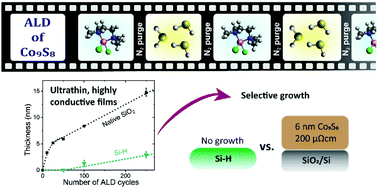Highly conductive and stable Co9S8 thin films by atomic layer deposition: from process development and film characterization to selective and epitaxial growth†
Abstract
Co9S8 is an interesting sulfide material with metallic conductivity that has shown promise for various energy applications. Herein, we report a new atomic layer deposition process producing crystalline, pure, and highly conductive Co9S8 thin films using CoCl2(TMEDA) (TMEDA = N,N,N′,N′-tetramethylethylenediamine) and H2S as precursors at 180–300 °C. The lowest resistivity of 80 μΩ cm, best uniformity, and highest growth rate are achieved at 275 °C. Area-selective deposition is enabled by inherent substrate-dependency of film nucleation. We show that a continuous and conductive Co9S8 film can be prepared on oxide-covered silicon without any growth on Si–H. Besides silicon, Co9S8 films can be grown on a variety of substrates. The first example of an epitaxial Co9S8 film is shown using a GaN substrate. The Co9S8 films are stable up to 750 °C in N2, 400 °C in forming gas, and 225 °C in O2 atmosphere. The reported ALD process offers a scalable and cost-effective route to high-quality Co9S8 films, which are of interest for applications ranging from electrocatalysis and rechargeable batteries to metal barrier and liner layers in microelectronics and beyond.

- This article is part of the themed collection: Spotlight Collection: Atomic and Molecular Layer Deposition


 Please wait while we load your content...
Please wait while we load your content...